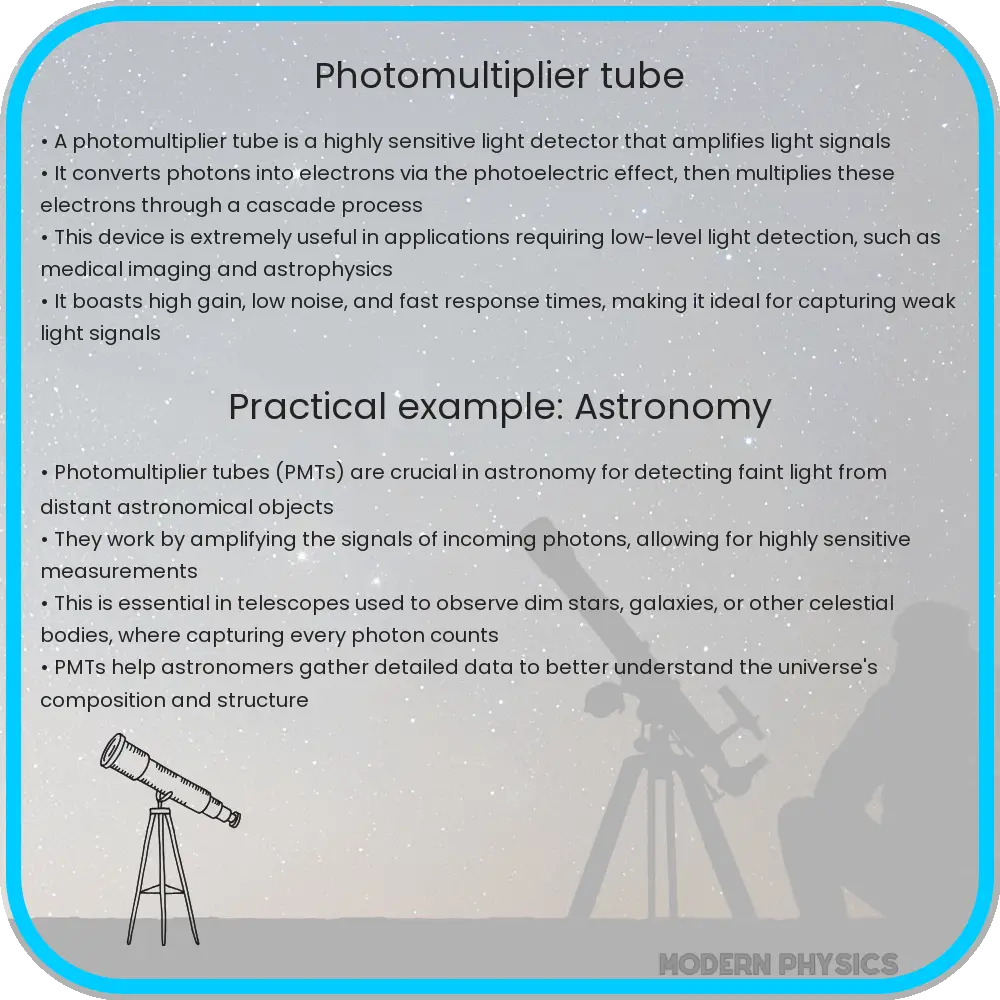Explore the world of Photomultiplier Tubes (PMTs), their working principles, applications, advancements, and future in this comprehensive guide.

Understanding Photomultiplier Tubes: Principles and Applications
Photomultiplier Tubes (PMTs) are highly sensitive detectors of light in the ultraviolet, visible, and near-infrared ranges. These devices are renowned for their exceptional sensitivity, speed, and accuracy in detecting light, making them indispensable in a wide range of scientific and industrial applications.
How Photomultiplier Tubes Work
At the heart of a PMT is the photoelectric effect. When photons hit the photocathode material of the PMT, they eject electrons due to their energy. This phenomenon is described by the equation: E = hf, where E is the energy of the photon, h is Planck’s constant, and f is the frequency of the light. These ejected electrons are then amplified through a series of dynodes – a process known as secondary emission – resulting in a significant amplification of the initial signal.
Key Features of Photomultiplier Tubes
- High Sensitivity: PMTs can detect single photons, making them extremely sensitive light detectors.
- Fast Response Time: They offer rapid response times, which are crucial in applications requiring high-speed light detection.
- Wide Spectral Response: PMTs are capable of detecting a range of wavelengths, from ultraviolet to infrared.
Applications of Photomultiplier Tubes
- Medical Imaging: In positron emission tomography (PET) and other imaging techniques, PMTs play a crucial role in detecting gamma rays and providing high-resolution images.
- Astronomy: PMTs are used in telescopes to detect faint light from distant stars and galaxies.
- Industrial Quality Control: They are employed in various industrial applications for their precision and accuracy in light detection.
Photomultiplier Tubes represent a perfect blend of quantum mechanics and practical engineering. Their ability to detect faint light signals with high accuracy and speed makes them invaluable in research and industry. In the following section, we will delve deeper into the technical aspects and recent advancements in PMT technology.
Advancements and Technical Aspects of Photomultiplier Tubes
Recent advancements in Photomultiplier Tube technology have further enhanced their capabilities. Modern PMTs exhibit improved quantum efficiency, meaning they can convert more incoming photons into electrons. Innovations in photocathode materials have expanded their spectral response, allowing for more versatile applications. Additionally, developments in tube design and dynode materials have led to better signal-to-noise ratios, crucial for high-precision measurements.
Challenges and Limitations
Despite their advantages, PMTs face certain limitations. They are sensitive to magnetic fields and require shielding in certain environments. Their vacuum tube construction makes them fragile and bulky compared to solid-state devices like photodiodes. Furthermore, PMTs require high voltage for operation, which can be a challenge in portable or battery-operated devices.
Future of Photomultiplier Tubes
The future of PMTs lies in overcoming these limitations while enhancing their inherent strengths. Research is ongoing in developing more robust and miniaturized PMTs, suitable for a wider range of applications. Integration with digital technologies and signal processing techniques also holds potential for expanding the utility of these devices in various scientific and industrial domains.
Conclusion
Photomultiplier Tubes stand as a testament to the fusion of quantum physics and engineering. Their unparalleled sensitivity, speed, and accuracy in light detection make them an essential tool in numerous fields, from medical imaging to astronomical research. Despite some challenges, ongoing advancements continue to expand their capabilities and applications. As technology progresses, PMTs will undoubtedly remain at the forefront of light detection, playing a crucial role in advancing our understanding of the world and the universe beyond.
In summary, Photomultiplier Tubes are more than just components; they are pivotal instruments that bridge the gap between theoretical physics and practical applications, driving innovation and discovery in an array of scientific endeavors.
